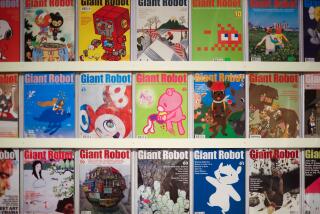Itâs life, in miniature
In 18th century Japan, the shogunate became alarmed at young lovers mimicking the double suicides they were seeing at the theater. What made the situation especially bizarre was that the couples were copying this behavior from puppets.
For nearly a century, 3-foot-high wooden performers had dominated entertainment in Japanâs commercial center, Osaka, overshadowing even the swashbuckling live-actor Kabuki. These Bunraku puppets enacted not only the exploits of samurai but also the emotions of shopkeepers and tradesmen -- people like their audience, some of whom apparently took the puppets as role models.
These days Bunraku, virtually unchanged since the mid-18th century, has been designated an âintangible cultural assetâ in its native country and a âmasterpiece of the oral and intangible heritage of humanityâ by UNESCO. Japanâs National Puppet Theatre, the repository of Bunraku, rarely tours abroad. But for the first time in nearly 20 years, the company will be performing this week in Los Angeles at the Japanese American Cultural & Community Center.
According to Peter M. Grilli -- president of the Japan Society of Boston, who spearheaded the U.S. tour along with the JACCC -- the artists involved are âamong the cream of the 80 or so Bunraku performers currently performing in Japan.â Grilli calls Bunraku the âmost seductive of all of Japanâs classical performance traditionsâ and says modern audiences âfall quickly under the spell of the puppets.â
Fair warning, though: The program includes suicides.
The art of Bunraku integrates puppetry, dramatic narration and music using a singular combination of refined technique and inspired chutzpah. The wood-and-fabric puppets are finely carved and painted. Some have movable eyes, eyebrows and mouths. Their articulated hands can curl in or arch out. Moods show in the tilt of a head or the subtle rise and fall of a chest -- the latter made of cloth draped over padded-wood shoulders and a bamboo hoop to define the hips.
Three men manipulate each puppet. One moves the feet (an art that, it is said, takes 10 years to learn), a second controls the left arm (which takes 10 more years to master), and the lead puppeteer works the head and right arm (which requires an additional decade of training). The simplest of actions can entail precise and tricky choreography.
If a shopkeeper counts money or a wife mends clothes, their two hands must synchronize perfectly. If a samurai spins, all three manipulators must either scamper around him or somehow reach around the puppet and their two fellow handlers without breaking the flow of the action.
Yet Bunraku gestures are not realistic. They express the core of feelings and actions, much as dance does. Yoshida Kazuo, a lead puppeteer on the tour, puts it this way: âWe convey emotion by distilling a human action and projecting its essential qualities. A female puppet walking or collapsing into tears is even more graceful than an actual woman.â
Coming to life without aping life is at the heart of Bunraku. Narrator Toyotake Rosetayu, another leading artist on the tour, demonstrates how he might impersonate a samurai, using a loud voice full of macho bravado, then explains, âNo real samurai ever spoke that way. Heâd be too exhausted to get through a single day. I exaggerate and distort the speech to express the samuraiâs inner qualities.â The great 18th century Bunraku playwright Chikamatsu Monzaemon summed it up: âArt exists in the slender margin between the real and the unreal.â
In fact, Bunrakuâs actual coup de theatre is its blatant flouting of realism, its daredevil theatricality, which turns the âwilling suspension of disbeliefâ into a high-wire act. The puppeteers make no effort to be inconspicuous. True, they are clad head to toe in black, which according to Japanese theatrical convention means they donât exist. But the lead manipulator for each puppet is not hooded. The audience can watch his focus and concentration as he projects life into his character. His face is, as it were, in the audienceâs face.
A photograph of Bunraku shows a stage crowded with men in black, dwarfing a few puppets. But for spectators at a performance, something else happens. The manipulators donât exactly disappear. They seem instead like the puppetsâ servants, or else the puppets seem to drag them around. And the presence of the puppeteers puts the characters into high relief. They become, in Grilliâs phrase, âmore than real.â
Puppetry existed in Japan as early as the Heian period (794-1185). Itinerant puppeteers performed in temples. Like many of their cohorts around Asia and Europe, they were social outcasts, considered the lowest of the low.
In the early 17th century, some joined their work with a lively form of narration called joruri and the music of the newly imported three-string samisen. These elements became so central that many people feel the main star of Bunraku is the tayu, who narrates the story and speaks for all the characters.
Chikamatsu Monzaemon also wrote for the Kabuki, with some of his plays thriving in both forms. The two theater styles cross-pollinated. Some of the larger-than-life gestures in Kabuki reflect the movements of puppets. And Bunraku actors perform a version of kabukiâs mie -- freeze-frame poses that cap intense emotional moments.
Just how deep this cross-breeding runs can be seen in the final scene of the play âOshichiâs Burning Love -- The Fire Watch Tower,â which will head the program in L.A.
This tear-jerker climaxes with Oshichi, the young heroine, climbing a fire alarm tower to ring a false alarm -- a capital crime -- to save her lover. Her ascent became such a Bunraku favorite that to this day, the Kabuki version often plays it as faux Bunraku: When the Kabuki Oshichi climbs the tower, black-clad âpuppeteersâ come onstage and pretend to manipulate her.
One way or another, in short, humans are still modeling their behavior on Bunraku.
--
Bunraku: The National Puppet Theatre of Japan
Where: Aratani / Japan America Theatre, 244 S. San Pedro St., L.A.
When: 8 p.m. Thursday and Friday, 2 and 8 p.m. Sunday
Price: $58 to $100
Contact: (213) 680-3700
More to Read
The biggest entertainment stories
Get our big stories about Hollywood, film, television, music, arts, culture and more right in your inbox as soon as they publish.
You may occasionally receive promotional content from the Los Angeles Times.










